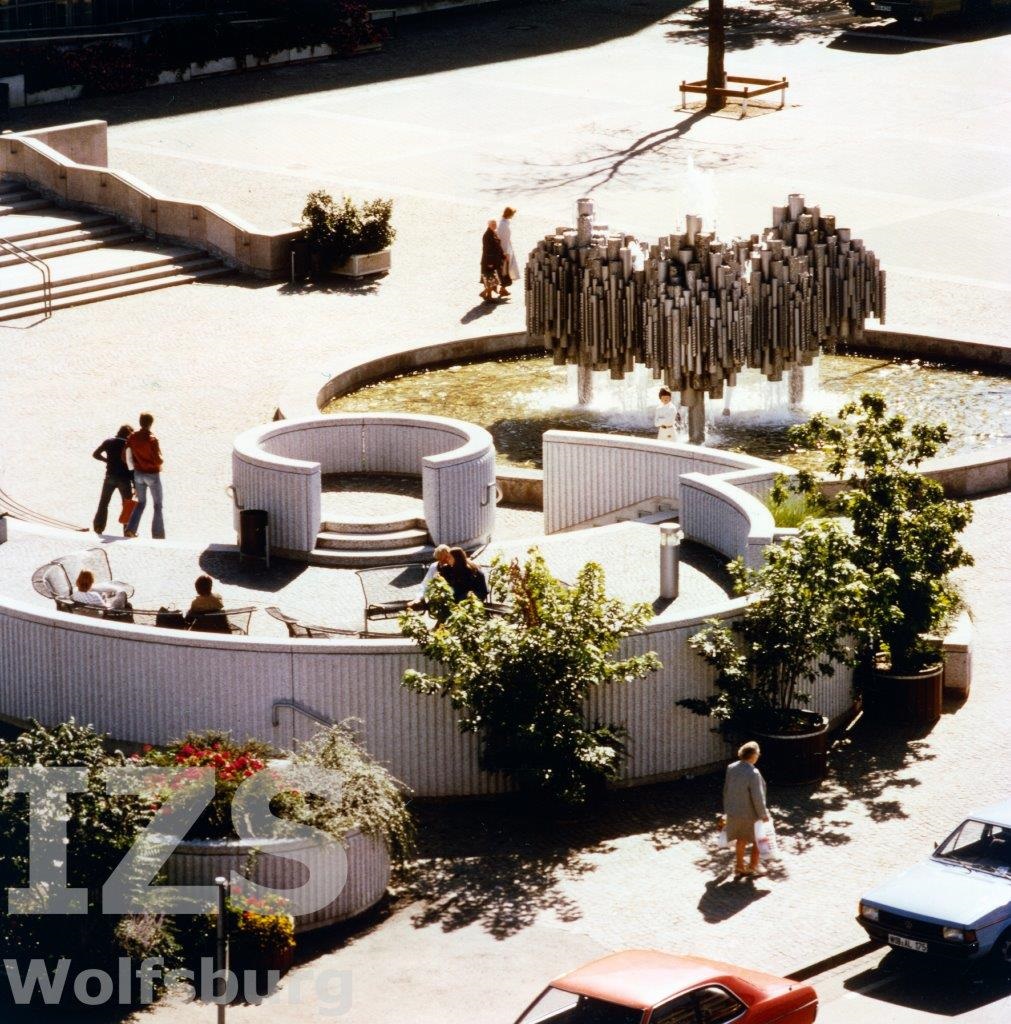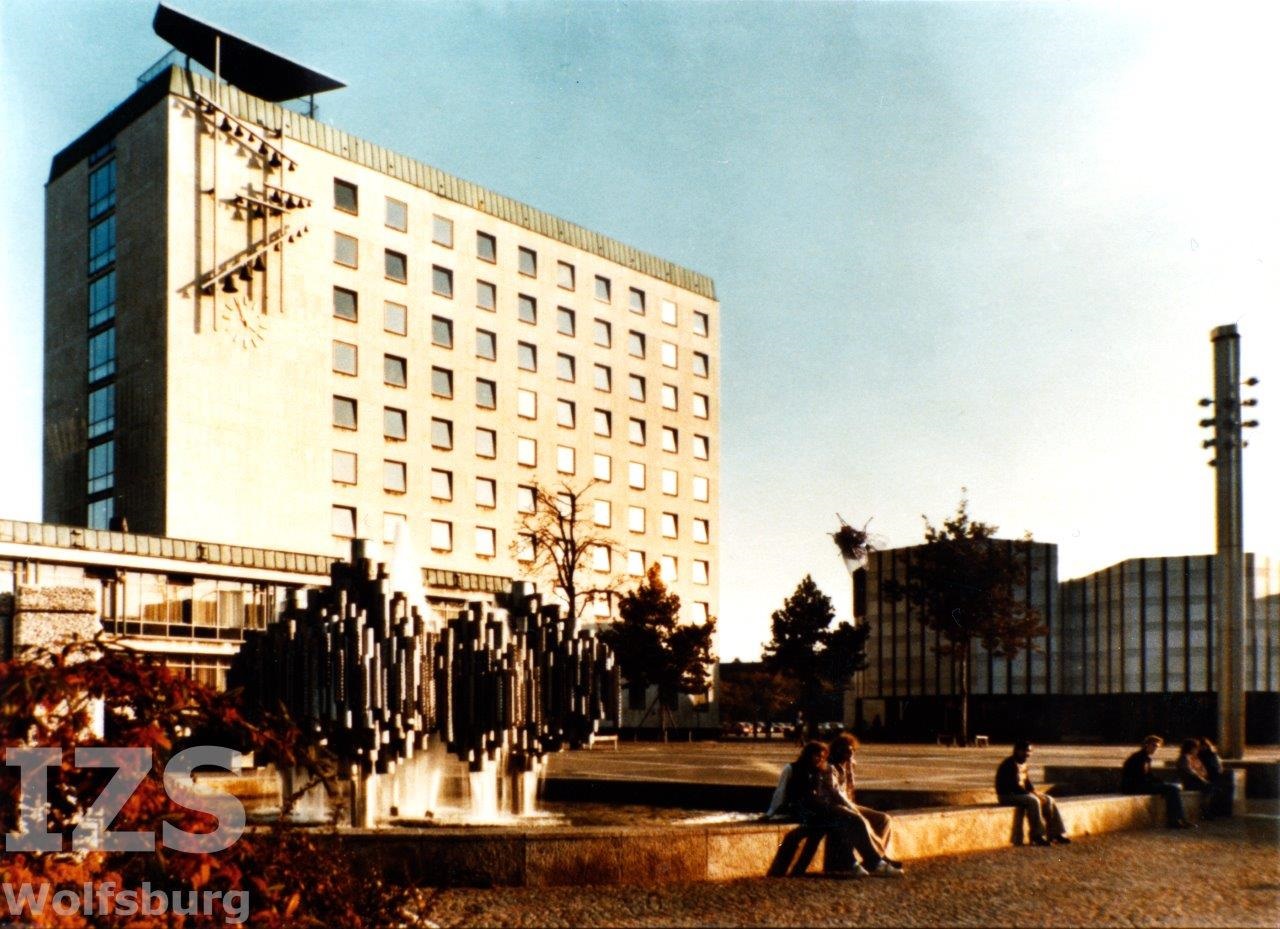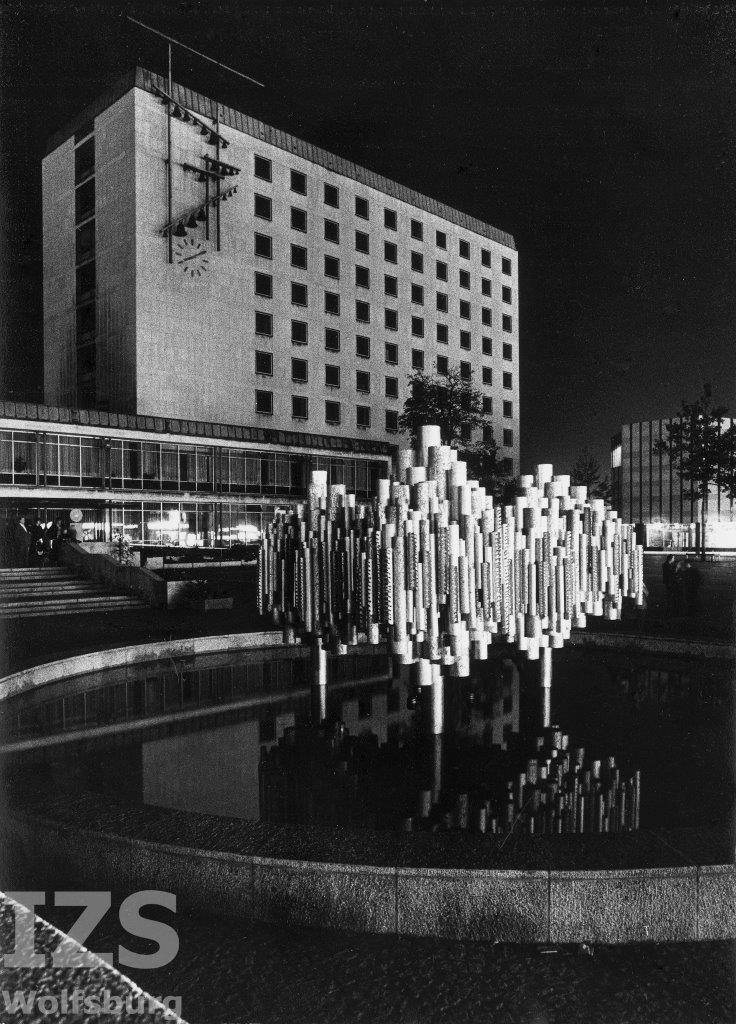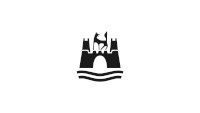Tube fountain, Rolf Hartmann (1977)
From Maik Ullmann
"For Rolf Hartmann, it was visibly an exciting hour in his life, because his art now forms a focal point in the city." -__-0000-__- With these sensitive words, the Wolfsburger Allgemeine Zeitung described the day on which the tubular fountain was installed in front of Wolfsburg town hall in the summer of 1977 (Fig. 1). -__-0001-__- There, the three-part bronze construction stands in a circular water basin in close proximity to Hartmann's bronze 'Grapschhand', as his first fountain on the town hall square is popularly known. Hartmann welded together numerous pipes with furrowed and smooth surfaces and varying lengths - at its highest point, the sculpture measures 3.50 meters - to form individual fountain elements, so that the construction visually resembles an organ pipe. This did not go unnoticed by the people of Wolfsburg, who gave the tubular fountain the nickname 'organ'. The pipe constructions are each supported by a central pipe, through which the water is fed before flowing back into the basin through many other pipes. Hartmann staged several water fountains between the elements, giving the uniform splashing of the fountain a bit of dynamism and more volume.

But the joy of the fountain sculpture's creator was probably short-lived. Because as early as September of that year, barely six weeks later, a plagiarism debate broke out about the fountain that has never completely died down to the present day. -__-0000-__- The debate began with an article in the Wolfsburger Allgemeine Zeitung on September 21, 1977, which already made the point in the headline: "Town hall fountain has its counterpart in Helsinki". -__-0001-__- The suspicion quickly arose that the artist had possibly copied the work of the sculptor Eila Hiltunen and her Sibelius Monument (1961-1967) in Finland. The city's press office immediately responded to the accusations made against the artist in the newspaper's own section Das freie Wort (The Free Word):
"During the consultation on the design of the fountain sculpture, the city was made aware of the similarity of the fountain sculpture to the Jean Sibelius Monument in Helsinki after the first publications in Wolfsburg's daily newspapers. The administration asked both the artist to make a statement and the art advisory board, which advises the city and makes recommendations to the council."-__-0002-__- An anonymous citizen also spoke out in the newspaper at the time after visiting the Sibelius monument in Helsinki himself and substantiated the accusations against the artist in a statement. His criticism was ultimately also directed at the local authority: he provocatively asked what the taxpayers in Wolfsburg would say about the fact that the administration had had an obvious plagiarism erected in front of the town hall. The writer concluded his submission with the words "Poor cultural advisory board".
However, the author of the letter could not have known this: Even before the sculpture was installed, the art advisory board had already dealt with the suspicion of plagiarism in the case of the fountain (Fig. 2). -__-0004-__-The obvious similarities could not be dismissed, it was said in the course of the discussion, but Hiltunen's monument deals centrally with organ pipes, while Hartmann's fountain primarily depicts a connection between steel pipes and water. In view of the colloquial designation of the tubular fountain as an 'organ', this association for the Wolfsburg fountain does not seem far-fetched either. Hartmann's former teacher Emil Cimiotti was also consulted, who considered his former pupil's stainless steel sculpture to be unobjectionable. Although the works were comparable, the artist could not be accused of plagiarism. They are "two different pairs of shoes", judged Art Advisory Board Chairman Volkmar Köhler. And so the art advisory board attested to Rolf Hartmann and his work as a contemporary exploration of sculptural forms, which could not be shown to be directly related to the Sibelius monument: "Contemporary art today shows certain tendencies and principles of form that cover each other, so that the results can be seen as independent works of art." Apart from an article in the Wolfsburger Allgemeine Zeitung two years later emphasizing the outward similarity, the debate initially fell silent for several years (Fig. 3).-__-0005-__-


This was to change in the fall of 1991, when lawyers for the artist Eila Hiltunen wrote to the Wolfsburg city council. -Their client had "accidentally" learned of a fountain sculpture in Wolfsburg's city center that was a "clear plagiarism" of her miniature of the Sibelius monument, which had been erected in front of the UNESCO Palace in Helsinki in 1967. The artist Rolf Hartmann had merely "copied it badly". Confronted with these new accusations, Hartmann wrote a detailed statement at the request of the administration:
"Since my youth - at the end of the 1950s - I have been involved with tube welding and cutting due to the technical training I received in my parents' company before I went to university, and I have developed works of art from this. Further inspiration for tube sculptures came -__-0001-__- also from Wolfsburg Castle Park, where, for example, an old, hollow tree inspired me to weld on tubes as early as the beginning of the 1960s. Myfriendship with the Wolfsburg sculptor Peter Szaif, whom I had assisted for a long time, also provided valuable inspiration."-__-0002-__-
The correspondence breaks off at this point. It is not clear from the files to what extent the legal dispute was continued or whether the parties were able to reach an agreement after all.
Rolf Hartmann and Eila Hiltunen were in fact not the only artists to experiment with tubes during the 1960s and 1970s. The Austrian sculptor Oswald Oberhuber and the German painter Gerhard Richter, among others, did the same, both sculpturally and non-representationally. It is quite possible that the artistic exploration of tubes was simply en vogue. At any rate, this is how Karl-Heinz Schulte, Head of Cultural Affairs in Wolfsburg, wanted to interpret it: "Today, tube art is 'in' throughout Europe, and Rolf Hartmann is also inspired by it." -__-0003-__- (Fig. 4) The discussion about the supposed plagiarism of the fountain erected so centrally in front of Wolfsburg's town hall is a vivid example of the tightrope act that every artist has to walk when it comes to measuring the pulse of the times and orienting their own work to it. It also shows how differently such accusations of plagiarism are dealt with by the public or politicians.

Sources
-__-0000-__- "The new town hall fountain came with a police escort", in: Wolfsburger Allgemeine Zeitung, August 1, 1977.
-__-0001-__- Gretl Hoffmann, Fountains and water features. Over 190 modern examples of private and public installations. Stuttgart 1980, p. 178.
-__-0002-__- "Bubbling art is not plagiarism", in: Wolfsburger Nachrichten from April 7, 2017.
-__-0003-__- "Rathaus-Brunnen hat sein Ebenbild in Helsinki", in: Wolfsburger Allgemeine Zeitung from September 21, 1977.
-__-0004-__- "Cursory comparison not sufficient", in: Wolfsburger Allgemeine Zeitung of September 24/25, 1977.
-__-0005-__- "A public waste...", in: Wolfsburger Allgemeine Zeitung of September 27, 1977.
-__-0006-__- Here and in the following StadtA WOB, Az. 41 51 10, Minutes of the 13th meeting of the Art Advisory Board of December 2, 1976.
-__-0007-__- Untitled, in: Wolfsburger Allgemeine Zeitung of June 20, 1979.
-__-0008-__- Here and in the following: IZS Wolfsburg, Az. 41 51 10, Kunst im Stadtbild, Rechtsanwälte Albers & Schultz an Stadt Wolfsburg, Amt für Kultur vom 11. Oktober 1991.
-__-0009-__- IZS Wolfsburg, ref. 41 51 10, Kunst im Stadtbild, Hartmann to the City of Wolfsburg dated November 17, 1991.
-__-0010-__- "Rathaus-Brunnen hat sein Ebenbild in Helsinki", in: Wolfsburger Allgemeine Zeitung of September 21, 1977.
